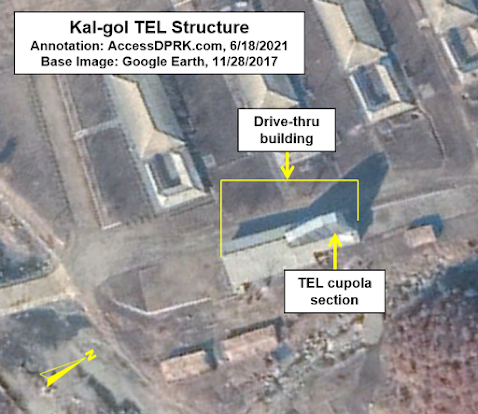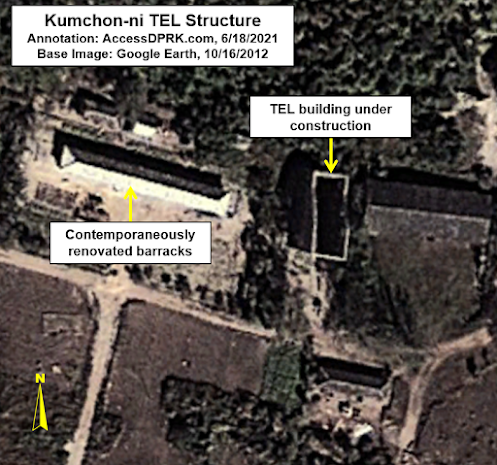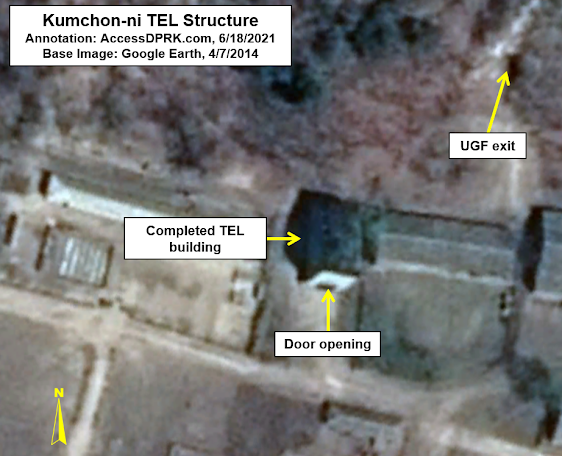This is the first of the supplemental articles for the Kim Jong-un's First Decade in Power series. It deals with vehicle ownership, the supply of fuel, and sanctions avoidance issues.
Introduction
I have written about this topic more than once as it intersects
with multiple areas of research, but one thing that has been made clear is that
the rise of the modern gas station within North Korea and changes toward ‘car
culture’ have largely been a product of Kim Jong-un’s rule.
Thanks to the publication of the AccessDPRK
2021 Pro Map and newer Google Earth imagery for most towns in North Korea, I
can now provide the most detailed picture yet of the country’s fueling
infrastructure; a picture that has been largely painted in Kim Jong-un’s first
decade in power.
Of the 157 gas stations that I have found, 149 of them have known
construction dates. And of those, 63.8% were constructed since Kim Jong-un came
to power. Additionally, four of the six stations whose exact year of
construction isn’t known were at least constructed on or after 2012, meaning
that two-thirds of all gas stations have been built in just the last decade.
While gas stations may not seem like an important topic, in the context of North Korea, they become a window into the country’s economy and reforms as they sit at the nexus of the growth of vehicle ownership, car culture, fuel imports, and sanctions avoidance activities.
To service an ever-larger vehicle fleet, whether they’re
state-owned or private, easy to access fuel needs to be made available. And to
keep those gas stations operational, a steady supply of refined petroleum must
also exist.
To cover this issue, this article will be broken down into three
main topics: vehicle ownership, gas station construction, and fuel supply and
sanctions.
Vehicle Ownership & Car Culture
The streets of Pyongyang, a city of 3 million, are famous for not
being full. Traffic jams are rare and brief, and most people get around by
subway or tram service. Outside of the capital, most people have to walk or
ride a bicycle. If they have a few extra won, they can jump on the back of a
farming truck or military vehicle to make their way. Long journeys are predominantly
taken via train.
So it might be surprising for many to know that North Korea has
its own automobile industry, of sorts. While North Korea has been producing various
vehicles since 1958, it wasn’t until the 2000s that they started to take the
idea of manufacturing non-commercial passenger vehicles seriously.
Established in 2000 as a joint venture with the South Korean-based
Unification Church as part of the South’s Sunshine Policy at
the time, Pyeonghwa Motors was meant to usher in a new era of not only economic
cooperation between the two countries, but also to help fulfill Pyongyang’s
desire to have a robust automotive industry.
Pyeonghwa’s plant in Nampo has a nominal capacity of 20,000 cars a
year, yet, in most years fewer than 1,000 vehicles were manufactured. Its peak was
in 2011 when 1,820 units were made. And like the products of North Korea’s other
vehicle plants, their creations are largely
Chinese-manufactured, DPRK-assembled car/truck/bus kits. The few models that
are predominantly manufactured within the country are merely modified copies of
foreign vehicles and still require many foreign parts.
However, even if North Korea has yet to develop its own truly
domestic and indigenous car manufacturing base, tens of thousands of cars,
trucks, and buses on North Korean roads come from North Korean factories, and
they are in enough numbers as to make up a sizable percentage of North Korea’s
entire vehicle fleet. What’s more, the regime has managed to import a
number of vehicles over years. Along with the increasing
privatization of transportation services (a reported
6,000 taxis are in Pyongyang alone) this has all helped keep urban populations
moving.
Regulations were relaxed in 2017 to allow for more car
registrations, as most passenger vehicles were still technically owned by state
enterprises and lent or leased out. Compared to the annual income of North
Koreans, prices are still prohibitively expensive, ranging from $10,000 to
$30,000 for most models, but it is estimated
that 20% of Pyongyang families now have their own cars thanks to a growing
middle class.
As mentioned, an alternative to outright ownership is “leasing”
them from a state firm. According to DailyNK,
this involves “The owner of the car must pay 150,000 KPW to the enterprise
for using their name and to make a working record, and also needs to pay 50,000
KPW each month to the Security Department for a license. In addition, they’ll
have to pay more than 300,000 KPW in bribes for various reasons”.
Despite supply challenges and the fact that cars are still a major
luxury, the regime has taken steps to normalize driving and to familiarize the
next generation with car culture, perhaps in anticipation of broader car
ownership in coming years.
In 2017 the government began to build children’s “traffic
parks” which are miniaturized city blocks with fake buildings, streets,
street signs, and even bridges. Kids are given mock cars to drive (pedal) around
with and learn the rules of the road. Most towns have at least one of these
parks while a few have had their construction delayed. In total, the AccessDPRK
database has located 149 driving parks.
These reforms and other changes also mark a change in ideology,
where having your own car isn’t just a decadent part of Western capitalism but
can be something to which citizens are implicitly told they can finally aspire
to. But to accomplish this, ready access to fuel is needed.
Gas Station Construction
Unlike in basically every other country on earth, getting fuel (gasoline or diesel) in North Korea has typically been restricted to those operating state-owned and military vehicles. People would get rations or would otherwise need to get permission from their factory, farm, or other work unit. From there, the fuel would have been distributed either from basic fuel tanks on site or would need to come from centralized fuel distribution centers that would send out fuel as needed. An example of one of these large depots can be found at 39.094342° 125.615611°.
Every town had fuel, but the concept of a western-style gas
station was mostly unknown, and I have only been able to locate 54 in the whole
country that existed prior to 2012. While the centralized supply of fuel seems
to have been adequate for most of the country’s history, it was simply too
complicated and the sites too remote to be responsive to the increase in
private vehicle ownership and in taxi and bus companies.
As the graph above shows, and corresponding with Kim Jong-un’s
assumption of power, there was a marked increase in the number of gas stations
being constructed each year from six 2012 to a peak of twenty-two in 2017. And
while the growth rate peaked in 2017, newly built gas stations have shown up
every single year. Additionally, many of the older sites have been renovated
and expanded within the same time frame.
While the beginnings of vehicle ownership and the establishment of
taxi companies began years earlier, there is no debate that this switch to a
more modern system of gas distribution has taken hold and was driven by the Kim
Jong-un regime.
Of course, this reform wasn’t done altruistically to make driving
around the country easier. The state issues permits for gas station construction
and state-owned companies have also been involved in the establishment and
operation of new sites, likely resulting in considerable annual revenue. One of
the most well-known cases of state ownership is the Air
Koryo gas station in Pyongyang’s Kangan District.
Since 2015, the state airline has been trying to diversify itself
and may operate several others gas stations. They also run a taxi service and a
food company. As NKNews notes,
Air Koryo is owned by the military and so these businesses are not only an
attempt to gain revenue for the government but for the military in particular.
In terms of design, many of the gas stations are stand-alone
structures that only provide fuel and perhaps small consumer goods like snacks
or phone cards, which most people around the world would find recognizable. Others
are part of larger facilities that include vehicle maintenance services for
commercial and passenger vehicles.
In a country where most vehicles are still used for industrial
purposes (materials transport, dump trucks, etc.) and where constant vehicle
maintenance is required, as most vehicles are decades old, clusters of these
stations are occasionally created to handle the demand.
An example of this can be seen at the Potonggang Reservoir in
Pyongyang where there are three distinct fueling and maintenance facilities
next to each other.
However, despite the clear rise in the number of gas stations, a
vision of long highways with gas stations dotting the landscape or where
there’s one on every corner in town is still a distant one. South Korea has an estimated
11,800 gas stations. Even when considering the South’s larger population and
economy, the fact that North Korea has fewer than 200 is a stark reminder of
how far the country must go to eventually become a nation that caters to the
driver.
There are very few gas stations along the country’s highways.
Along the major Reunification Highway, for the nearly 100 km distance between
Sariwon and Kaesong there are no evident gas stations. And in the country’s
interior regions there aren’t any of the modern sites outside of major towns.
Drivers must rely on the old method of getting refueled and would be well
advised to carry an emergency supply of gas with them.
Indeed, the decades of fuel scarcity led to the adoption of wood gasification in countless vehicles. And while modern gas stations are spreading, they still remain largely confined to major cities – particularly those cities involved in international trade. The seven cities of Pyongyang (47), Sunchon (10), Rason (8), Chongjin (7), Hamhung (7), Nampo (6), and Sinuiju (6) hold nearly two-thirds of all gas stations in the country.
Fuel Supply, Sanctions, and Sanctions Avoidance
It is important to note that while gas stations have spread around
the country, most places still rely on the more traditional way of getting fuel
into vehicles. These fueling compounds can be found all over the country and
many have been renovated over the years. This implies that the new gas stations
built in the last decade have not merely been replacing an existing system, but
that they are creating a net increase in demand.
This need for more petroleum supplies has been demonstrated by the
expansion of
the Nampo fuel terminal and the construction of storage tanks in other parts of
the country as well. In Nampo, since 2018 more than 30 storage tanks have been
added or are under construction.
As North Korea lacks any natural oil reserves, the United Nations
has placed sanctions limiting how much it can import as a result of its nuclear
and missile programs. This sanctions
regime only allows for 500,000 barrels of refined petroleum and 4
million barrels of crude oil products to be imported each year.
To get around sanctions, North Korea has been employing ship-to-ship
transfers (STS) and then brings their newly loaded vessels into a home port
to offload the illegal petroleum products. Each transfer can provide North
Korea with anywhere from 500,000 to over 1 million liters of oil (6,289
barrels).
Based on United Nations reporting and using publicly available
ship tracking data, there are six primary vessels engaged in STS activities
along with several smaller vessels. Each ship can make numerous transfers a
year. In 2020, the US found 32 individual
instances of fuel being smuggled to DPRK ships within Chinese waters, while
the Chinese government was alerted by the UN to 46 instances of smuggling
activities via STS.
All of this adds up to a lot of fuel coming into the country.
According to the 2020 UN Panel of Experts report, the US estimates that “under
the one-third laden scenario, these deliveries would have amounted to almost three
times the total cap of 500,000 barrels set in paragraph 5 of resolution
2397 (2017). Under the half-laden scenario, the deliveries would have amounted
to more than four times the cap and, under the fully laden scenario,
they would have amounted to almost eight times the cap.” (emphases
added)
But ship-to-ship transfers aren’t the only way North Korea can get
illicit petroleum. There is an aging but still operational pipeline from China
that is owned and operated by China National Petroleum Corp. North Korea’s only
functional oil refinery, the Ponghwa Chemical Factory, is also located nearby,
enabling them to convert crude oil from the pipeline into other needed
products.
While China is party to the UN sanctions against North Korea,
enforcement of those sanctions is left up to each member state, and the pipeline is not monitored by independent organizations.
In
2016, an estimated 270,000 tonnes (36,800 barrels) of fuel – both
gasoline and diesel – was transferred to North Korea through the pipeline
according to official Chinese data. A further 520,000 tonnes (70,900 barrels)
of crude oil was also sent. However, customs data isn’t always made available
and it has been notoriously unrealizable. What’s more, is the pipeline’s
ability to transfer not just crude oil but refined products as well. At full
flow, it could send eight
times North Korea’s annual legal allotment.
A 2020 report by The Nautilus Institute reveals that oil transfer via pipeline is still ongoing through this COVID-era, even if other import methods have temporarily been restricted. Its authors estimate that crude oil exports by the Dandong-Sinuiju Pipeline from China in 2019 came to 715,000 tons (approx. 5.2 million barrels), but increased those exports to nearly 750,000 tons (almost 5.5 million barrels) in 2020 – far in excess of UN limits.
The current trade restrictions imposed by Pyongyang due to COVID
has likely impacted a range of smuggling activities, but it seems rather clear that North
Korea has the networks of ships, allies, and infrastructure to routinely
surpass international limits.
And the operation of gas stations is one key to realizing that fact.
Satellite imagery exists of many of the gas stations during different
phases of construction. Through these images one can see that each gas station
typically has 2-4 (sometimes more) fuel storage tanks. But to err on the side
of conservative estimates, I will use two tanks as the average.
Using measurements
attained from “Wonsan Station #2” at 39.142021° 127.385198°, I estimate that
each fueling tank has a capacity to store 7,733 gallons (184 barrels) of
gasoline. If we assume that all of the 103 identified gas stations built
in the last decade have the same sized tanks, only have two of them, and are
refilled only once a month, then the demand for additional fuel products has
risen by 19,115,976 gallons (455,142 barrels) each year of refined petroleum.
That’s almost the country’s entire legal import limit just to operate these new
gas stations and is based on using conservative estimates.
Busier stations will need more. Numerous gas stations have 4+
storage tanks. Some tanks are larger. Therefore, the actual supply needs could
easily be greater.
There are still the other 54 older gas stations, there’s still the
centralized distribution network that those in rural areas rely on, there’s
still the need for aviation fuel, heavy fuel oil, and the need for supplies for
their fishing fleet and military vehicles.
Of course, their refinery can produce refined products, but the
point is that nearly half a million barrels of gas is now – newly – in demand,
a demand that has not been accounted for by adjusting sanctions levels. A
demand, it seems, that can only be realistically met through illicit imports.
~ ~ ~ ~
I have scheduled this project to run through to the end of the
year, with a new article coming out roughly every 10 days or so. If you would
like to support the project and help me with research costs, please consider
supporting AccessDPRK
on Patreon. Those supporters donating $15 or more each month will be entitled
to a final PDF version of all the articles together that will also have
additional information included once the series is finished. They will also
receive a Google Earth map related to the events in the series.
Supporters at other levels will be sent each new article a day
before it’s published and will also receive a mention as seen below.
I would like to thank my current Patreon supporters: Amanda O., GreatPoppo, Joel Parish, John Pike, Kbechs87, Rinmanah, Russ Johnson, and ZS.
























